Fig. 4. Regulatory signaling pathways and defense mechanisms implicated in the process of ferroptosis.
Iron metabolism has been associated with ferroptosis (top left). As the body’s principal organ for storing excess iron and synthesizing hepcidin, the liver serves as the functional cornerstone in maintaining iron homeostasis. When cellular iron is sufficient, transferrin-bound iron decreases in order to limit excessive iron accumulation. Under iron-overload conditions, excess iron results in redox-active non-transferrin-bound iron (NTBI), the uptake of which is mediated by metal transporter proteins such as SLC39A14. In general, excess iron is stored in ferritin and free iron existing as part of the LIP can be accumulated due to imbalanced metabolism. NOCA4 has been shown to act as a cargo receptor that binds to ferritin delivering it to the autolysosome, resulting in releasing of free iron. Free iron participates in the generation of ROS through Fenton reaction. ACSL4 and LPCAT3 are necessary for ferroptosis to produce PUFAs-PE. The activation of ALOXs, POR, or NOXs promotes lipid peroxidation, yet the activation of ESCRT complex repairs cell membrane damage. Lipid peroxidation of membrane phospholipids can be eliminated by three parallel metabolic pathways, including the cyst(e)ine/GSH/GPX4 axis (top right), as well as the CoQ10/FSP1 and GCH1/BH4/DHFR axis (bottom left). In mitochondrial, DHODH and mitoGPX4 participated in ROS scavenging. In addition, several transcription factors such as p53, NRF2, ATF4, and YAP/TAZ regulate ferroptosis-related genes upon oxidative stress (bottom right). ABCB6, ATP-binding cassette subfamily B member 6; LOXs, lipoxygenases; ACSL4, acyl-CoA synthetase long-chain family member 4; ATF4, activating transcription factor 4; BACH1, BTB domain and CNC homolog 1; BH2, 7,8-dihydrobiopterin; BH4, tetrahydrobiopterin; CDKN1A, cyclin-dependent kinase inhibitor p21; CHMP5/6, chromatin modeling protein 5/6; CoQ10H2, ubiquinol; GCH1, guanosine triphosphate cyclohydrolase 1; DHFR, dihydrofolate reductase; DHODH, dihydroorotate dehydrogenase; DDP4, dipeptidyl peptidase-4; DMT1, divalent metal transporter1; EMP1, epithelial membrane protein 1; ESCRT-III, endosomal sorting complex required for transport III; FPN, Ferroportin; FSP1, ferroptosis suppressor protein 1; FTH, ferritin heavy chain; FTL, ferritin light chain; GCS, glutamylcysteine synthetase; GPX4, glutathione peroxidase 4; GCH1, guanosine triphosphate cyclohydrolase 1; GSH, glutathione; HO-1, heme oxygenase 1; LIP, labile iron pool; LPCAT3, lysophosphatidylcholine acyltransferase 3; MTX, methotrexate; mTORC1, mechanistic target of rapamycin complex 1; NRF2, nuclear factor erythroid 2-related factor 2; NCOA4, nuclear receptor coactivator 4; PCBP, poly (RC)-binding proteins; POR, NADPH-cytochrome P450 reductase; PUFA, polyunsaturated fatty acid; ROS, reactive oxygen species; STEAP3, six-transmembrane epithelial antigen of prostate 3; TF, transferrin; TFR1, transferrin receptor 1; TXNRD1, thioredoxin reductase 1; TRPML1/2, Mucolipin TRP channel 1/2.

